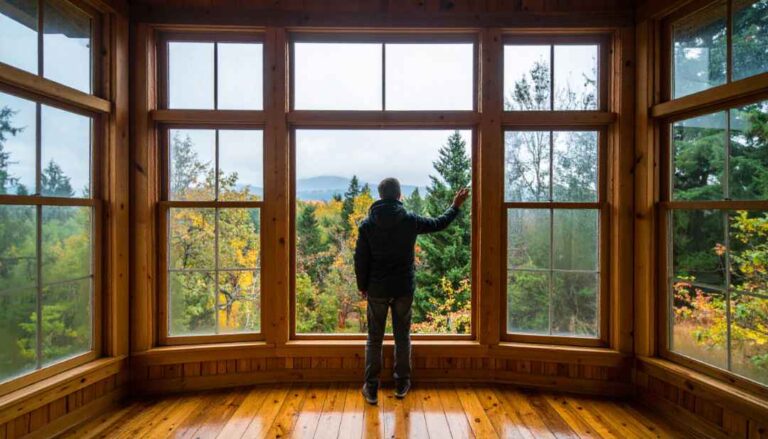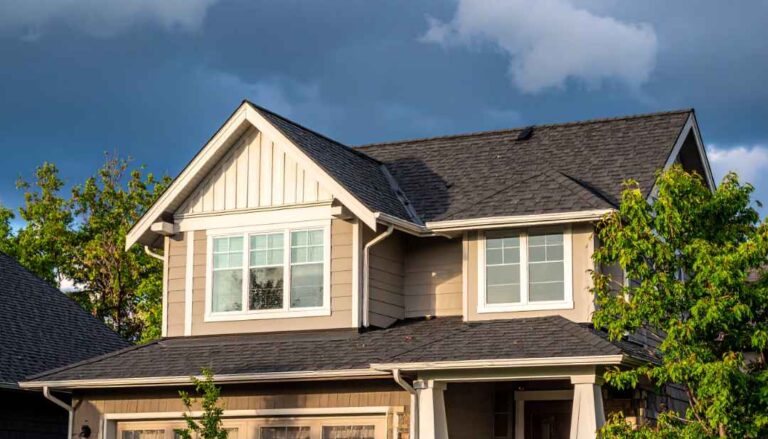he Hidden Threat – Why Your Attic is Your Roof’s Secret Keeper
The fury of a Chicagoland storm can leave its mark on your home’s exterior in obvious ways: missing shingles, bent gutters, or even fallen branches. You might survey your roof from the ground, see nothing overtly wrong, and breathe a sigh of relief. However, often the most damaging and insidious effects of a storm are hidden from plain sight, deep within your attic.
Your attic is the first line of defense behind your roof. It’s where subtle leaks, often invisible from the exterior, first manifest, accumulating moisture that can lead to wood rot, mold growth, compromised insulation, and eventually, costly structural damage to your home. In Illinois, where we experience heavy rains, strong winds, and significant snow and ice, knowing how to properly check your attic for roof leaks after a storm is a critical skill for any homeowner.
At Seidel Exterior Group, we’ve been expertly identifying and repairing roof leaks for Chicagoland homeowners since 1970. We understand that early detection is paramount to preventing minor issues from escalating into major problems. This article will guide you through a step-by-step internal inspection of your attic, detailing exactly what to look for and when to call in the professionals to safeguard your home.
Why an Attic Inspection is Essential After Every Storm
Even if your roof looks fine from the street, a professional external roof inspection (which Seidel Exterior Group always recommends after a storm) and an internal attic check are crucial for several reasons:
- Early Detection: Leaks often start small. Water might seep through a tiny crack in a shingle or compromised flashing, slowly saturating the roof decking or insulation before it’s visible anywhere else in your home. Your attic is the first place these signs appear.
- Preventing Escalation: A slow, undetected leak can lead to severe structural damage over time, causing wood rot in rafters and trusses, weakening your roof’s integrity, and leading to mold and mildew growth that can spread rapidly.
- Preserving Insulation: Wet insulation loses its effectiveness dramatically, leading to higher energy bills as your home struggles to retain heat in winter or cool air in summer.
- Avoiding Mold and Health Hazards: Trapped moisture in the attic creates a perfect breeding ground for mold and mildew. Mold can cause respiratory issues, allergies, and other health problems, and its remediation is costly and complex.
- Validating Insurance Claims: Early and thorough documentation of internal water damage supports your insurance claim, linking the interior damage directly to the roof leak caused by the storm.
How to Safely Check Your Attic for Roof Leaks: A Step-by-Step Guide
Safety First: Before you even think about entering your attic, prioritize safety.
- Wait for the Storm to Pass: Never enter your attic during an active storm or if there’s any risk of lightning.
- Lighting is Key: Bring a powerful flashlight or, even better, a headlamp, as attics are usually dimly lit.
- Wear Protective Gear: Long sleeves, long pants, gloves, a dust mask (to avoid inhaling insulation fibers or mold spores), and sturdy closed-toe shoes are essential.
- Watch Your Footing: Always step only on the wooden joists or trusses. Never step directly on the ceiling drywall or insulation, as you could fall through. If you’re unsure about stable footing, lay down temporary plywood boards to create a walking path.
- Beware of Electrical Wires: Be mindful of exposed wiring. Do not touch any wires.
- Pest Awareness: Attics can harbor pests (rodents, insects). Be aware of your surroundings.
- Heat/Cold: Attics can be extremely hot in summer or cold in winter. Dress appropriately and don’t stay too long if conditions are uncomfortable.
- When in Doubt, Don’t Go: If your attic access is difficult, the space is extremely cramped, or you feel uncomfortable or unsafe for any reason, stop and call a professional.
Now, let’s proceed with the inspection:
Step 1: Look and Listen for Immediate Signs of Water
- Visual Scan: Shine your flashlight slowly across the entire underside of your roof decking (the wood or plywood visible from inside the attic). Look for any areas that appear darker than the surrounding wood. Fresh water will often make wood appear significantly darker.
- Active Leaks: If it’s still raining (or raining again after you noticed exterior damage), try to perform the inspection during the rain. This can make active drips or trickles of water easier to spot. Listen for dripping sounds.
- Puddles: Look for any standing water on the attic floor, insulation, or on exposed joists. This indicates a more significant leak that has been ongoing or is very severe.
Step 2: Focus on Common Leak Sources
Most roof leaks occur around penetrations or transitions where the roof plane is broken. Pay extra attention to these areas:
- Around Chimneys: Meticulously inspect the wood framing and insulation around your chimney. Look for dark stains, dampness, or actual drips. Often, flashing around the chimney is a source of leaks.
- Near Vent Pipes and Exhaust Fans: Check around all plumbing vent pipes, attic fans, and bathroom/kitchen exhaust fan ducts. Look for stains or moisture around the collars and where they meet the roof decking. (Ensure exhaust fans are venting outside, not just into the attic!)
- Around Skylights: Inspect all four sides of any skylights for water stains, dampness, or drips, especially in the corners or where the skylight frame meets the roof decking.
- Valleys: These are the V-shaped channels where two roof planes meet. Water volume is highest here, and compromised valley flashing is a common leak source. Look for dampness or stains along the entire length of the valley from below.
- Around Gable Vents/Walls: If your attic has vertical walls (like those of a dormer or a gable end), check where the roof meets these walls for signs of water intrusion.
- Nail Pops/Shiners: Look for nails protruding through the roof decking that have moisture or frost on them (in winter), or signs of rust around them. These “shiners” indicate moisture is getting in, often due to inadequate ventilation leading to condensation, but sometimes direct leaks.
Step 3: Inspect Your Attic Insulation
- Damp or Discolored Insulation: Visually inspect your insulation. Wet insulation will appear darker, clumped, matted down, or discolored (yellow, brown, or even black from mold).
- Sagging Insulation: Saturated insulation becomes heavy and can sag between joists.
- Mold/Mildew on Insulation: Look for fuzzy, black, green, or white patches on the insulation itself.
- Performance Impact: Damp insulation loses its R-value (insulating power), making it less effective at regulating your home’s temperature.
Step 4: Check for Mold and Musty Odors
- Visual Check for Mold: Look for any fuzzy, slimy, or discolored growth (black, green, white, grey) on wooden rafters, trusses, the underside of the roof decking, or on insulation. Mold can be patchy or widespread.
- Smell Test: Use your nose. A persistent musty, earthy, or damp odor is a strong indicator of hidden moisture and potential mold growth, even if you can’t visually see it.
Step 5: Look at the Exterior Wall Sheathing/Framing
- Water Trails: Sometimes water can run down the inside of exterior walls from the attic. Look for water stains or dampness on the top plates of the wall framing that extend downward.
Step 6: Review Interior Ceilings and Walls Directly Below the Attic
- Water Stains: Even if you didn’t find a leak in the attic, check the ceilings and top portions of walls in rooms directly below the attic. Yellow, brown, or copper-colored stains are clear signs of water intrusion that has made it through the attic floor.
- Sagging Ceiling: A sagging ceiling can indicate significant water saturation and a potential ceiling collapse. This requires immediate professional attention.
- Peeling Paint or Bubbling Drywall: Water behind paint or drywall can cause it to bubble, blister, or peel.
What to Do if You Find a Leak (Or Suspect One)
- Contain the Water (Temporarily): If you find an active drip, place a bucket or container directly beneath it to catch the water and prevent further interior damage.
- Move Valuables: If water is threatening personal belongings, move them to a dry area.
- Document Everything (Again!): Take more photos and videos of the leak, the water stains, and any damp or moldy areas. This is crucial for your insurance claim.
- Do NOT Attempt Complex DIY Repairs: Identifying a leak’s source and repairing it properly from the exterior requires specialized knowledge, tools, and safety equipment. Attempting a DIY repair can be dangerous, ineffective, and may even void your roofing warranty.
- Contact Your Insurance Company: Notify your homeowner’s insurance provider immediately, especially if the leak is severe or appears to be related to recent storm damage.
- Call Seidel Exterior Group for a Professional Roof Inspection! This is the most important next step.
Why a Professional Roof Inspection is Crucial (The Seidel Exterior Group Advantage)
While your internal attic inspection is a vital first step, it cannot replace the thorough assessment provided by a professional roofing contractor like Seidel Exterior Group.
- Accurate Leak Source Identification: Our experts can pinpoint the exact source of the leak from the exterior (damaged shingles, compromised flashing, nail pops, etc.), which is often difficult to do from the attic alone. We know where to look and how to access all vulnerable areas safely.
- Uncovering Hidden Exterior Damage: Often, the damage causing the leak on the interior isn’t obvious from the ground. We identify subtle hail impacts, wind uplift that compromised shingle seals, or deteriorating flashing that homeowners might miss.
- Comprehensive Damage Assessment: We assess the full extent of the storm damage to your entire roof system, including any damage to the decking, underlayment, and ventilation.
- Expert Repair & Restoration: We don’t just patch; we provide lasting repairs or replacement solutions using high-quality materials and certified installation techniques to ensure your roof is fully restored and protected.
- Insurance Claim Assistance: We have extensive experience working with insurance adjusters in Chicagoland. We can provide detailed documentation, meet with your adjuster on-site, and help you navigate the claim process to ensure you receive a fair and comprehensive settlement.
- Preventative Solutions: We can advise on long-term solutions, like improving attic ventilation, to prevent future moisture issues and ice dams that plague Illinois homes.
Your Attic Holds the Key to Your Roof’s Health
Your attic serves as an early warning system for roof leaks and moisture problems that can silently undermine your home’s integrity. By conducting a careful post-storm inspection, you empower yourself to detect these issues early, preventing costly structural damage, mold growth, and escalating repairs.
However, accurately diagnosing the source of a leak and implementing effective, lasting repairs requires the expertise of seasoned professionals. Don’t let a “hidden leak” become a major headache.
If your Chicagoland home has weathered a recent storm, and you suspect any signs of a leak or moisture in your attic, don’t delay. Contact Seidel Exterior Group today for a free, comprehensive roof inspection. Our experts are ready to uncover the unseen, safeguard your home, and restore your peace of mind.



